|
|
High-Speed Serial Interface (HSSI) Interface Processor (HIP) Installation and Configuration
Product Numbers: CX-HIP=, CAB-HSI1=, and CAB-HNUL=
This document contains instructions for installing or replacing the High-Speed Serial Interface (HSSI) Interface Processor (HIP) in Cisco 7000 series and Cisco 7500 series routers. These procedures contain basic configuration steps and examples so that you can bring the interface up and verify that the HIP is installed correctly. For complete descriptions of interface subcommands and the configuration options available for HSSI interfaces, refer to the appropriate software publications.
Sections in this document include the following:
![]()
This section provides a brief description of the Cisco 7000 series and Cisco 7500 series routers and the HIP. For complete physical and functional descriptions of these products, refer to the hardware installation and maintenance publication appropriate for your chassis model.
The HIP provides a single HSSI network interface for Cisco 7000 series and Cisco 7500 series routers. Network interfaces reside on modular interface processors, which provide a direct connection between the high-speed CxBus and CyBuses and the external networks. All interface processors support online insertion and removal (OIR), which allows you to remove or install interface processors without opening the chassis or shutting down the system.
The HIP, shown in Figure 1, provides a full-duplex (FDX) synchronous serial interface for transmitting and receiving data at rates of up to 52 megabits per second (Mbps). The HSSI interface, which was recently standardized as EIA/TIA 612/613, provides access to services at T3 (45 Mbps), E3 (34 Mbps), and Synchronous Optical Network (SONET) STS-1 (51.82 Mbps) rates. The actual rate of the interface depends on the external data service unit (DSU) and the type of service to which it is connected. The HIP supports both 16- and 32-bit cyclic redundancy checks (CRCs). The default is 16-bit CRCs; to enable 32-bit CRCs, you use a configuration command, depending on the hardware version of your HIP. For a description of the CRC function, refer to the section "Configuring Cyclic Redundancy Checks" on page 24.
Figure 1 : High-Speed Serial (HSSI) Interface Processor (HIP)
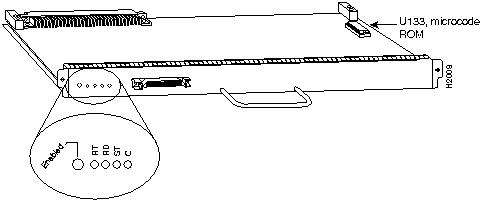
The default HIP microcode resides on a read-only memory (ROM) device in socket U133. (See Figure 1.)
The HSSI interface port is a female, 50-pin, SCSI-II-type connector. You must use an HSSI interface cable to connect the HIP with an external DSU. Refer to the section "HIP Cables" on page 4 for descriptions of HSSI interface cables.
You can install a HIP in any available interface processor slot in the Cisco 7000 series and Cisco 7500 series routers; there are no restrictions on slot locations or sequence.
After system initialization, the enabled LED, which is present on all interface processors, goes on to indicate that the HIP has been enabled for operation. The following conditions must be met before the HIP is enabled:
If any of these conditions is not met, or if the initialization fails for other reasons, the enabled LED does not go on.
The four status LEDs on the HIP indicate the following:
Microcode, also known as firmware, is a set of processor-specific software instructions that enables and manages the features and functions of a specific processor type. Each system contains the latest available microcode version for each processor type when it leaves the factory (the default microcode). At system startup or reload, the system loads the microcode for each processor type present in the system.
The default HIP microcode resides on ROM in socket U133. New microcode is released to enable new features, improve performance, or fix bugs in earlier versions. The Cisco 7000 series and Cisco 7500 series routers feature downloadable software and microcode for most upgrades. These features enable you to download new (upgraded) images remotely, store the images in router memory, and load the new images at system startup without having to physically access the router. You can store multiple versions for a specific processor type, and use configuration commands to specify which version the system should load at startup. All interfaces of the same type (for example, all HIPs) use the same microcode image. Although most upgrades can be downloaded, some exceptions require ROM replacement to ensure proper startup and operation.
Microcode images that are bundled with the system image load automatically along with the new software image; however, you can use configuration commands to override the bundled microcode image and instead load an image from ROM or a Flash file. For configuration instructions, refer to the section "Upgrading and Configuring Microcode" on page 25.
Two types of cables are available for use with the HIP: the HSSI interface cable used to connect your router to an external DSU (and HSSI network) and a null modem cable, which allows you to connect two routers back to back.
The HSSI interface cable connects the HIP with the external DSU. Figure 2 shows the 50-pin connector used at each end of the HSSI interface cable. Table 1 lists the connector pinouts.
Figure 2 : HSSI Interface Cable Connector
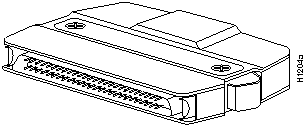
Table 1 : HSSI Interface Cable Pinout
|
Signal Name |
Pin No. + Side (Router End) |
Direction1 |
Pin No. -- Side (DSU End) |
|---|---|---|---|
| SG (Signal Ground) | 1 | --- | 26 |
| RT (Receive Timing) | 2 | <--- | 27 |
| CA (DCE Available) | 3 | <--- | 28 |
| RD (Receive Data reserved) | 4 | <--- | 29 |
| LC (Loopback circuit C) | 5 | <--- | 30 |
| ST (Send Timing) | 6 | <--- | 31 |
| SG (Signal Ground) | 7 | --- | 32 |
| TA (DTE Available) | 8 | ---> | 33 |
| TT (Terminal Timing) | 9 | ---> | 34 |
| LA (Loopback circuit A) | 10 | ---> | 35 |
| SD (Send Data) | 11 | ---> | 36 |
| LB (Loopback circuit B) | 12 | ---> | 37 |
| SG (Signal Ground) | 13 | --- | 38 |
| 5 (Ancillary to DCE) | 14--18 | ---> | 39--43 |
| SG (Signal Ground) | 19 | --- | 44 |
| 5 (Ancillary from DCE) | 20--24 | <--- | 45--49 |
| SG (Signal Ground) | 25 | --- | 50 |
The null modem cable can connect two routers directly, back to back. The two routers must be in the same location and can be two Cisco 7000 series and Cisco 7500 series routers, two AGS+ routers, or one of each. A null modem connection allows you to verify the operation of the HSSI or to link the routers directly in order to build a larger node.
The null modem cable uses the same 50-pin connectors as the HSSI interface cable, but uses the pinouts listed in Table 2. For connection and configuration instructions, refer to the section "Connecting a Null Modem Cable" on page 28.
Table 2 : HSSI Null Modem Cable Pinout
What Is the Cisco 7000 Series?
The Cisco 7000 series consists of the seven-slot Cisco 7000 and the five-slot Cisco 7010. Both models use the same Route Processor (RP), Switch Processor (SP), Silicon Switch Processor (SSP) and interface processors. The Cisco 7000 provides five interface slots and offers a second modular power supply for redundant power. The Cisco 7010 provides three interface processor slots, and offers the same performance as the Cisco 7000 at a lower cost.
Figure 3 shows the interface processor end of the Cisco 7000, which provides access to the seven slots and the removable power supplies. When facing the interface processor end of the chassis, the RP and SP (or SSP) slot are on the far right. The five interface processor slots are numbered 0 to 4 from left to right.
Figure 3 : Cisco 7000, Interface Processor End
Figure 4 shows the interface processor end of the Cisco 7010 model, which provides access to the five slots, the AC input receptacle, the power switch, and a power status indicator. When facing the interface processor end of the chassis, the RP and SP (or SSP) slots are at the top. The three interface processor slots are numbered from the bottom up from slot 0 through 2 (the center slot).
Figure 4 : Cisco 7010, Interface Processor End
In both models, interface processor slots support any combination of network interface types: Ethernet, Fast Ethernet, Token Ring, Fiber Distributed Data Interface (FDDI), serial, channel attachment, multichannel interface, and HSSI. The RP, SP (or SSP), and interface processors are keyed with guides on the backplane to prevent them from being fully inserted in the wrong slot.
What Is the Cisco 7500 Series?
The Cisco 7500 series consists of three router models: the Cisco 7505, the Cisco 7507, and the Cisco 7513. All three models provide high reliability, availability, serviceability, and performance. The three systems support multiprotocol, multimedia routing, and bridging with a wide variety of protocols and any combination of Ethernet, Fast Ethernet, Token Ring, Fiber Distributed Data Interface (FDDI), serial, multichannel, channel attachment, and High-Speed Serial Interface (HSSI) media. Network interfaces reside on modular interface processors, which provide a direct connection between the high-speed, 1.067-gigabits-per-second (Gbps) Cisco Extended Bus (CyBus) and the external networks.
Figure 5 shows the rear of the five-slot Cisco 7505 router. In the Cisco 7505, one slot (4) is reserved for the Route Switch Processor (RSP1), which contains the system processor and performs packet switching functions. Slots 0 through 3 are for interface processors.
Figure 5 : Cisco 7505, Interface Processor End
Figure 6 shows the rear of the seven-slot Cisco 7507 router. In the Cisco 7507, up to two slots (2 and 3) are reserved for the Route Switch Processor (RSP2), which contains the system processor and performs packet switching functions. Slots 0 and 1, and 4 through 6 are for interface processors.
Figure 6 : Cisco 7507, Interface Processor End
Figure 7 shows the rear of the Cisco 7513, with two AC-input power supplies installed. Two slots (6 and 7) are reserved for the second generation Route Switch Processor (RSP2), which contains the system processor and performs packet switching functions. Slots 0 through 5, and 8 through 12 are for interface processors.
Figure 7 : Cisco 7513, Interface Processor End
Before you install the HIP, review the safety and ESD-prevention guidelines in this section to avoid injuring yourself or damaging the equipment. This section also lists the software requirements and provides a list of parts and tools you will need to perform the installation.
The HIP is compatible with any Cisco 7000 series and Cisco 7500 series router that is operating with the following software and microcode:
The show version command displays the current hardware configuration of the router, including the system software version that is currently loaded and running. The show microcode command lists the following: the current hardware version of installed processor modules, the currently loaded and running microcode version for each processor type, and the target microcode version. (Refer to the section "Command Descriptions and Examples" on page 29.)
You can determine the current version of software or microcode stored in ROM either by removing the processor module and checking the ROM labels or by configuring the system to boot the system software or microcode from ROM, reloading the system, and using show commands to check the version that is loaded and running. For basic configuration information, refer to the section "Configuring the HIP" on page 21. Also refer to the Router Products Configuration Guide for complete configuration instructions and examples.
If the displays indicate that the required system software and microcode is not available in your system, contact a customer service representative for upgrade information. (Refer to the section "Cisco Information Online" on page 31.)
This section lists safety guidelines you should follow when working with any equipment that connects to electrical power or telephone wiring.
Follow these basic guidelines when working with any electrical equipment:
Use the following guidelines when working with any equipment that is connected to telephone wiring or to other network cabling:
Preventing Electrostatic Discharge Damage
Electrostatic discharge (ESD) damage, which can occur when electronic cards or components are improperly handled, results in complete or intermittent failures. Each processor module contains a printed circuit card that is fixed in a metal carrier. Electromagnetic interference (EMI) shielding, connectors, and a handle are integral components of the carrier. Although the metal carrier helps to protect the board from ESD, use an ESD-preventive wrist or ankle strap whenever you handle any electronic system component. Handle processor modules by the handles and the carrier edges only; never touch the boards or connector pins.
Following are guidelines for preventing ESD damage:
Online Insertion and Removal---An Overview
Online insertion and removal (OIR) allows you to remove and replace interface processors while the system is operating; you do not need to notify the software or shut down the system power. This section describes the mechanical functions of the system components and stresses the importance of following the correct procedures to avoid unnecessary restarts or card failures. This section is for background information only. Subsequent sections provide specific procedures for removing and installing an AIP. All CxBus and CyBus interface processors support OIR
Each processor module contains a bus connector with which it connects to the system backplane. The bus connector is a set of tiered pins, in three lengths. The pins send specific signals to the system as they make contact with the backplane. The system assesses the signals it receives and the order in which it receives them to determine what event is occurring and what task it needs to perform, such as reinitializing new interfaces or shutting down removed ones. For example, when you insert an interface processor, the longest pins make contact with the backplane first, and the shortest pins make contact last. The system recognizes the signals and the sequence in which it receives them. The system expects to receive signals from the individual pins in this logical sequence, and the ejector levers help to ensure that the pins mate in this sequence.
When you remove or insert an interface processor, the backplane pins send signals to notify the system, which then performs as follows:
OIR functionality enables you to add, remove, or replace interface processors with the system online, which provides a method that is seamless to end users on the network, maintains all routing information, and ensures session preservation.
When you insert a new interface processor, the system runs a diagnostic test on the new interfaces and compares them to the existing configuration. If this initial diagnostic test fails, the system remains off line for another 15 seconds while it performs a second set of diagnostic tests to determine whether or not the interface processor is faulty and if normal system operation is possible.
If the second diagnostic test passes, which indicates that the system is operating normally and the new interface processor is faulty, the system resumes normal operation but leaves the new interfaces disabled. If the second diagnostic test fails, the system crashes, which usually indicates that the new interface processor has created a problem on the bus and should be removed.
The system brings online only interfaces that match the current configuration and were previously configured as up; all other interfaces require that you configure them with the configure command. On interface processors with multiple interfaces, only the interfaces that have already been configured are brought online. The new interface remains in the administratively shutdown state until you configure it and bring it online.
The function of the ejector levers (see Figure 8) is to align and seat the card connectors in the backplane. Failure to use the ejectors and insert the interface processor properly can disrupt the order in which the pins make contact with the backplane.
It is also important to use the ejector levers when removing an interface processor to ensure that the board connector pins disconnect from the backplane in the logical sequence expected by the system. Any processor module that is only partially connected to the backplane can hang the bus. Detailed steps for correctly performing OIR are included with the following procedures for installing and removing a FIP.
Figure 8 : Ejector Lever and Captive Installation Screw You need the following tools and parts to install or replace a HIP. If you need additional equipment, contact a service representative for ordering information.
The following sections provide a functional overview of online insertion and removal (OIR), and describe the procedures for installing or replacing interface processors in Cisco 7000 series and Cisco 7500 series routers. Before installing any new interfaces, ensure that your system meets the minimum software and microcode requirements described in the section "Required Parts and Tools" on page 16.
The OIR feature allows you to remove and install a HIP without turning off system power. However, you must follow the insertion instructions carefully; for example, failure to use the ejector levers or insert the HIP properly can cause system error messages indicating a board failure.
Each unused interface processor slot contains an interface processor filler (which is an interface processor carrier without an interface board) to keep dust out of the chassis and to maintain proper air flow through the interface processor compartment. If you install a new HIP, select an empty interface processor slot and remove the interface processor filler. If you replace a HIP, you can retain the existing interface configuration by removing the existing HIP and installing the new one in the same slot.
Following the OIR overview, proceed to the section "Removing a HIP or an Interface Processor Filler" for instructions on making an interface processor slot available for the new HIP, then for the installation instructions, refer to the section "Installing a HIP" on page 18. After the new HIP is secure, to verify that it is installed and functioning properly, follow the procedures in the section "Checking the Installation."
Removing a HIP or an Interface Processor Filler
If you are installing a new HIP, select an available slot and remove the interface processor filler. If you are replacing a HIP, first remove the existing HIP and immediately place it component side up on an antistatic surface, then insert the new HIP in the same slot to retain the previous configuration for the new HSSI interface.
Figure 9 shows proper handling of an interface processor for installation in the Cisco 7010 and Cisco 7505 models. The processor slots are oriented horizontally in the Cisco 7010 and Cisco 7505, and vertically in the Cisco 7000, Cisco 7507, and Cisco 7513.
Figure 9 : Handling Interface Processors During Installation (Horizontal Orientation)
Figure 8 shows the functions of the ejector levers in the correct orientation for the horizontal processor slots in a Cisco 7010 and Cisco 7505 chassis. In a Cisco 7000, Cisco 7507, and Cisco 7513 chassis, the function of the ejectors is the same, but the orientation is rotated 90 degrees clockwise for the vertical processor slots.
Refer to Figure 8 while performing the following steps to remove a HIP or interface processor filler. If you are removing an interface processor filler, proceed to step 2. If you are replacing an existing HIP, begin at step 1.
This completes the removal procedure. Proceed to the next section to install a new HIP.
The HIP slides into any available interface processor slot and connects directly to the backplane. The backplane slots are keyed so that the HIP can be installed only in an interface processor slot. Figure 8 shows the functional details of inserting an interface processor and using the ejectors. Figure 9 shows proper handling of an interface processor during installation.
Follow these steps to install a HIP:
This completes the installation. Proceed to the next section to check the installation.
After you install the HIP, verify the installation by observing the LED states and the console display. When the system has reinitialized all interfaces, the enabled LED on the HIP and on all interface processors should go on. The console screen will also display a message as the system discovers each interface during its reinitialization.
When you remove and replace interface processors, the system provides status messages on the console screen. These messages are for information only. The following sample display shows the events logged by the system as a HIP was removed from slot 1; the system then reinitialized the remaining interface processors and marked as down the HIP that was removed from slot 1. When the HIP was reinserted, the system marked the interface as up again because the HSSI interface was not shut down before the HIP was removed.
When a new HIP is inserted or when a HIP is moved to a new slot, the system recognizes the new HSSI interface, but leaves the interface in a down state until you configure it and change the state to up with the configure command. The following example display shows the events logged by the system as a new HIP is inserted in slot 3:
Verify that the HIP is installed correctly as follows:
If an error message is displayed on the console terminal, refer to the appropriate software publication for error message definitions. If you experience other problems that you are unable to solve, contact a service representative for assistance.
This completes the HIP installation. If you installed a new HIP, you must now configure the new HSSI interface, as described in the following section.
If you installed a new HIP or if you want to change the configuration of an existing interface, you must enter the configuration mode. If you replaced a HIP that was previously configured, the system will recognize the new HIP and bring it up in the existing configuration.
After you verify that the new HIP is installed correctly (the enabled LED goes on---see Figure 10), use the privileged-level configure command to configure the new HSSI interface.
Be prepared with the information you will need, including the following:
Refer to the appropriate software documentation for descriptions of the configuration options available and instructions for configuring an HSSI interface.
The configure command requires privileged-level access to the EXEC command interpreter, which usually requires a password. Refer to the description that follows and contact your system administrator if necessary to obtain access.
Using the EXEC Command Interpreter
Before using the configure command, enter the privileged level of the EXEC command interpreter with the enable command. The system will prompt you for a password if one has been set.
The system prompt for the privileged level ends with a pound sign (#) instead of an angle bracket (>). At the console terminal, enter the privileged level as follows:
Proceed to the following sections to shut down and configure the HSSI interface.
Before removing an interface that you will not replace, or replacing a microcode ROM or other replaceable interface processor component, shut down (disable) the interfaces to prevent anomalies when you reinstall the new or reconfigured interface processor. When you shut down an interface, it is designated administratively down in the show command displays.
Follow these steps to shut down an interface:
For complete descriptions of configuration commands, refer to the Router Products Configuration Guide publication.
Following are instructions for a basic configuration: enabling an interface and specifying IP routing. Depending on the requirements for your system configuration and the protocols you plan to route on the interface, you might also need to enter other configuration subcommands.
Cisco 7000 series and Cisco 7500 series routers identify an interface address by its slot number and port number (port numbers 0 through 7, depending on the interface processor type) in the format slot/port. Because each HIP contains a single HSSI interface, the port number is always 0. For example, the slot/port address of an HSSI interface installed in interface processor slot 1 is 1/0.
The following steps show a basic configuration. Press Return after each configuration step unless otherwise noted.
Proceed to the following sections to check the interface configuration with show commands.
Configuring Cyclic Redundancy Checks
The HIP uses a 16-bit CRC by default, but also supports a 32-bit CRC, depending on the hardware version of your HIP.
CRC is an error-checking technique that uses a calculated numeric value to detect errors in transmitted data. The sender of a data frame divides the bits in the frame message by a predetermined number to calculate a remainder or frame check sequence (FCS). Before it sends the frame, the sender appends the FCS value to the message so that the frame contents are exactly divisible by the predetermined number. The receiver divides the frame contents by the same predetermined number that the sender used to calculate the FCS. If the result is not 0, the receiver assumes that a transmission error occurred and sends a request to the sender to resend the frame.
The designators 16 and 32 indicate the number of check digits per frame that are used to calculate the FCS. CRC-16, which transmits streams of 8-bit characters, generates a 16-bit FCS. CRC-32, which transmits streams of 16-bit characters, generates a 32-bit FCS. CRC-32 transmits longer streams at faster rates, and, therefore, provides better ongoing error correction with fewer retransmissions. To prevent errors, both the sender and the receiver must use the same CRC setting.
The default for all HIP interfaces is for 16-bit CRC.
To enable 32-bit CRC on an interface, follow steps 1 and 2 of the preceding procedure (enter configuration mode and specify the slot and port address of the hssi interface) and enter the command crc32. Enter Ctrl-z to exit from configuration mode.
In the example that follows, a HIP in interface processor slot 2 is configured for 32-bit CRC:
To disable CRC-32 and return to the default CRC-16 setting, specify the slot and port address and use the no crc32 command. For complete command descriptions and instructions, refer to the related software documentation.
Upgrading and Configuring Microcode
At system startup or reload, the system loads a microcode image for each processor type. The factory default for Cisco 7000 series systems running Software Release 9.17(6) and earlier is to load the images from the individual microcode ROMs on the processors. The default for systems running Software Release 9.17(7) and later is to bypass the ROM microcode and load the microcode images bundled with the system image. All processors of the same type use the same microcode image; only one image for each type can load at startup. This section describes how to modify the startup configuration to load different microcode images at startup, or to change existing configuration instructions and reenable the system default.
In order to use the new image, you have to modify the configuration file and instruct the system to load the new image stored in Flash memory instead of the ROM image.
The default is to ignore the ROM microcode and load the microcode images that are bundled with the system image. The ROM images serve as backups; if the system cannot load a bundled microcode image, it will use the ROM image instead.
Whenever you upgrade software or microcode by downloading new images into Flash memory, you must configure the system to load the new image at startup. Otherwise, the system will continue to load the default images from ROM, or attempt to load the previous image (if any) if it is still specified in the configuration file.
To instruct the system to boot a microcode image other than the default at startup, use the configuration command microcode processor type [flash | rom] filename to add the instructions to the configuration file. All processors of the same type (for example, all HIPs or all EIPs) will load the same microcode image, either from the default source or from the source you specify.
Follow these steps to configure the microcode for a specific processor:
This completes the procedure for configuring microcode. For descriptions of the show commands, refer to the section "Command Descriptions and Examples" on page 29.
Checking the Configuration Using show Commands
After configuring the new interface, use the following show commands to display the status of the new interface or all interfaces. For detailed command descriptions and examples, refer to the section "Command Descriptions and Examples" on page 29.
If the interface is down and you configured it as up, or if the displays indicate that the hardware is not functioning properly, ensure that the network interface is properly connected and terminated. If you still have problems bringing the interface up, contact a service representative for assistance. For descriptions of the show commands, refer to the section "Command Descriptions and Examples" on page 29. This completes the configuration procedure for the new HSSI interface.
The null modem cable can connect two routers directly back to back. The two routers must be in the same location, and can be two Cisco 7000 series router, two Cisco 7500 series routers, or one of each. This setup allows you to verify the operation of the HSSI port or to directly link the routers in order to build a larger node. The null modem cable uses the same 50-pin connectors as the HSSI interface cable, but uses the pinouts listed in Table 2.
To connect two routers, attach a null modem cable between an HSSI port on each router. Enable the internal transmit clock in both routers by entering the command hssi internal-clock.
You define AGS+ interfaces by interface type and logical interface (unit) number (address), and Cisco 7000 series and Cisco 7500 series interfaces by interface type and physical slot/port location. (The output of the show interfaces command displays the logical unit number in both router types and the physical slot/port location in the Cisco 7000 series and Cisco 7500 series.) Both router platforms use the same hssi internal-clock command to enable the internal transmit clock on the HSSI interface.
The following examples show the configure command syntax for the Cisco 7000 series, Cisco 7500 series, and the AGS+. For complete configuration descriptions and examples, refer to the appropriate software publications.
Be sure to configure the HSSI port on both routers for an internal transmit clock. When the internal clock is enabled, the ST LED goes on. When the internal clock is enabled in both routers, the ST and RT LEDs on both of the connected HSSI ports go on. The LEDs on the Cisco 7000 series and Cisco 7500 series HIP, and the AGS+ CSC-(C2)HSCI HSSI interfaces, are identical.
To disconnect the null modem cable, disable the internal transmit clock with the command no hssi internal-clock. Use this command to turn off the transmit clock for each port on both routers.
This reference section provides a summary of show commands that you can use to verify the current system status and configuration, guidelines for returning parts to the factory (if you are required to do so), and phone numbers for obtaining technical assistance.
Command Descriptions and Examples
This section describes the various show commands that you can use to display system status and configuration.
The show controllers cxbus command lists all interfaces and includes the currently loaded and running microcode version for each. The show version command displays the current hardware configuration of the router, including the system software version that is currently loaded and running.
You can check the version of the default ROM image either by removing the board and checking the ROM labels or by configuring the interface or system software to boot from ROM, restarting the system, and using these same commands to check version is running.
Use the show version command to display the current system software version, and use the show controllers cxbus command to display the microcode version of the SP (or SSP) and each interface processor. In the following example of the show version command, Cisco IOS Release 9.17(5) is the system software that is running (in a Cisco 7000 series router).
In the following example of the show controller cxbus command display, the SP (or SSP) microcode is Version 1.2 although the microcode ROM on the SP (or SSP) contains Version 1.0. (In this example, ROM Version 1.0 is assumed because you cannot determine the ROM version with screen displays unless it is the running version.)
If the resulting displays indicate that the running system software is earlier than Cisco IOS Release 9.17(3), in your Cisco 7000 series router, or that the running SP (or SSP) microcode is an earlier version than Version 1.2, check the contents of Flash memory to determine whether the required images are available on your system. (If the required images are available, you can use configuration commands to instruct the system to download the correct image before you install the new HIP.) The show flash command displays a list of all files stored in Flash memory.
The following example shows that FIP Microcode Version 1.1 and SP (or SSP) Microcode Version 1.2 are stored in Flash.
If a required image is stored in Flash, but is not currently running, refer to the section "Upgrading and Configuring Microcode" on page 25 to load the correct microcode, or to the document Upgrading System Software and Microcode in Cisco 7000 series Routers (Document Number 78-1144-xx) to load the correct software.
The command show interfaces serial slot/port displays statistics for the specific serial interface you specify by its slot/port address. If you use this command without the type and slot/port arguments, the system will display statistics for all interfaces in the system:
The command show configuration displays the contents of the system configuration file stored in NVRAM. This file should reflect all new configuration changes you made and wrote to memory using the write terminal command.
The command show protocols displays the global (system-wide) and interface-specific status of any configured level 3 protocol.
Cisco Information Online (CIO) is Cisco Systems' primary, real-time support channel. Maintenance customers and partners can self-register on CIO to obtain additional content and services.
Available 24 hours a day, 7 days a week, CIO provides a wealth of standard and value-added services to Cisco's customers and business partners. CIO services include product information, software updates, release notes, technical tips, the Bug Navigator, configuration notes, brochures, descriptions of service offerings, and download access to public and authorized files.
CIO serves a wide variety of users through two interfaces that are updated and enhanced simultaneously---a character-based version and a multimedia version that resides on the World Wide Web (WWW). The character-based CIO (called "CIO Classic") supports Zmodem, Kermit, Xmodem, FTP, Internet e-mail, and fax download options, and is excellent for quick access to information over lower bandwidths. The WWW version of CIO provides richly formatted documents with photographs, figures, graphics, and video, as well as hyperlinks to related information.
You can access CIO in the following ways:
For a copy of CIO's Frequently Asked Questions (FAQ), contact
Copyright 1988-1996 © Cisco Systems Inc.
![]()
Signal Name
From Pins
Direction
To Pins
Signal Name
RT (Receive Timing)
2, 27
--->
9, 34
TT (Terminal Timing)
CA (DCE available)
3, 28
--->
8, 33
TA (DTE Available)
RD (Receive Data)
4, 29
--->
11, 36
SD (Send Data)
LC (Loopback C)
5, 30
--->
10, 35
LA (Loopback A)
ST (Send Timing)
6, 31
--->
6, 31
ST (Send Timing)
TA (DTE available)
8, 33
--->
3, 28
CA (DCE Available)
TT (Terminal Timing)
9, 34
--->
2, 27
RT (Receive Timing)
LA (Loopback A)
10, 35
--->
5, 30
LC (Loopback C)
SD (Send Data)
11, 36
--->
4, 29
RD (Receive Data)
GND (Ground)
1, 26,
7, 32,
13, 38,
19, 44,
25, 50
1, 26,
7, 32,
13, 38,
19, 44,
25, 50
GND (Ground)
Loopback (not connected)
12, 37
12, 37
Loopback (not connected)
Not used
14--18, 20--24, 39--43, 45--49
14--18, 20--24, 39--43, 45--49
Not used
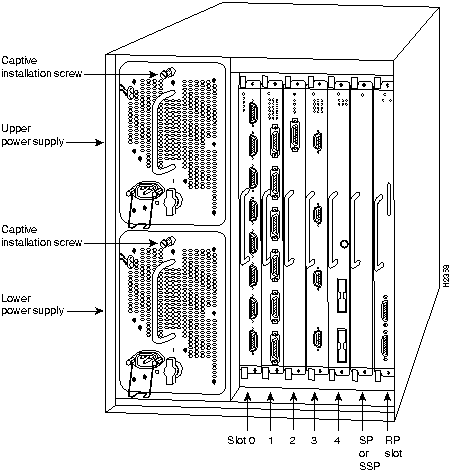
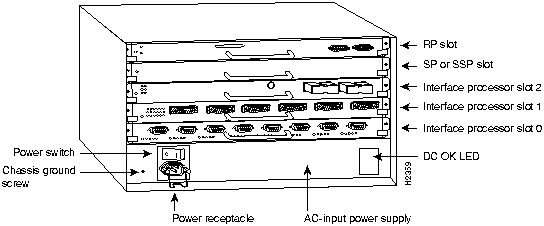

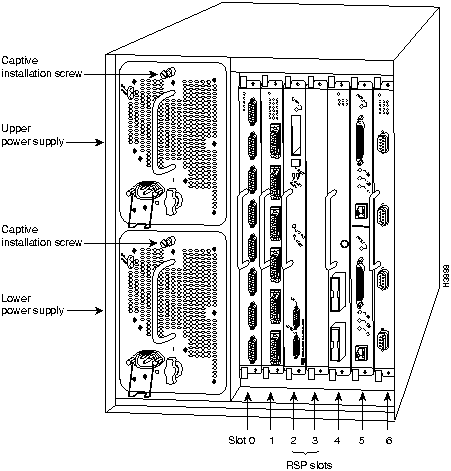
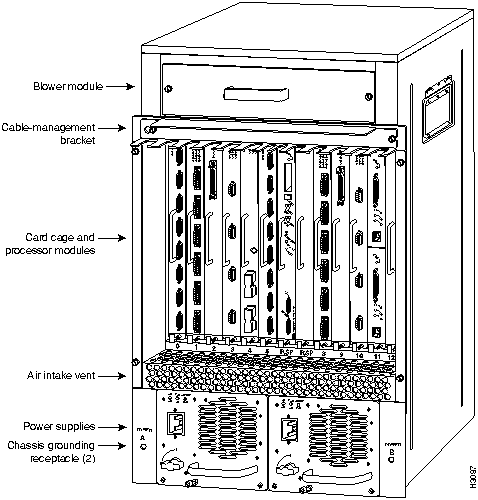
![]()
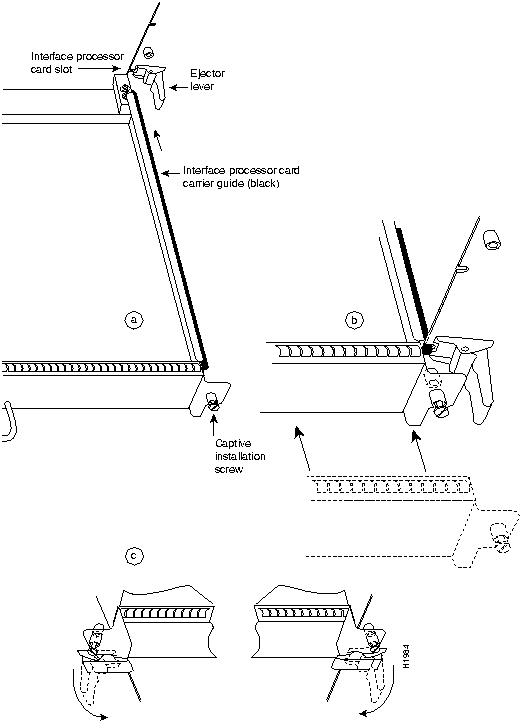
![]()
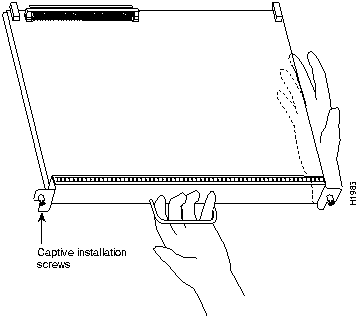
![]()
![]()
Router#
%OIR-6-REMCARD: Card removed from slot 1, interfaces disabled
%LINK-5-CHANGED: Interface Hssi1/0, changed state to administratively down
Router#
%OIR-6-INSCARD: Card inserted in slot 1, interfaces administratively shut down
%LINK-5-CHANGED: Interface Hssi1/0, changed state to up
Router#
%OIR-6-INSCARD: Card inserted in slot 3, interfaces administratively shut down

Router>
enable
Password:
Router#
Router#
configure terminal
Enter configuration commands, one per line. End with CNTL/Z.
Router(config)#
Router(config)#
interface
hssi 1/0
Router(config-int)#
shutdown
Router(config-int)#
interface hssi 0/0
Router(config-int)#
shutdown
Router(config-int)#
interface hssi 2/0
Router(config-int)#
shutdown
Router(config-int)#
^z
Router#
Router#
copy running-config startup-config
[OK]
Router#
Router#
show interface hssi 1/0
Hssi 1/0 is administratively down, line protocol is down
Hardware is cxBus HIP
[additional display text omitted]
Router(config-int)#
interface hssi 1/0
Router(config-int)#
no shutdown
Router(config-int)#
^z
Router#
copy running-config startup-config
[OK]
Router#
show interface hssi 1/0
Hssi 1/0 is up, line protocol is up
Hardware is cxBus HIP
[additional display text omitted]
Router#
configure terminal
Enter configuration commands, one per line. End with CNTL/Z.
Router(config)#
Router(config)#
interface
hssi 1/0
Router(config-int)#
ip address 145.22.4.67 255.255.255.0
Router(config-int)#
no shutdown
Router#
copy running-config startup-config
[OK]
Router#
Router#
disable
Router>
Router# configure terminal
Enter configuration commands, one per line. End with CNTL/Z.
Router(config)#
Router(config)# interface hssi 2/0
Router(config-int)# crc32
Router(config-int)# ^z
Router#
show flash
4096K bytes of flash memory on embedded flash (in RP1).
file offset length name
0 0x40 55410 sp1-2
1 0xD0D4 53364 hip1-1
[4085336/4194304 bytes free]
Router#
configure terminal
Enter configuration commands, one per line. End with CNTL/Z.
Router(config)#
Router(config)#
microcode hip rom
Router(config)#
no microcode hip flash hip1-1
Router(config)#
microcode hip flash hip1-1
Router#
copy running-config startup-config
[OK]
Router#
Cisco7000/7500Series# configure terminal
Enter configuration commands, one per line. End with CNTL/Z.
Router(config)#
Enter configuration commands...
Cisco7000/7500Series(config)# interface hssi 2/0
Cisco7000/7500Series(config-int)# hssi internal-clock
Cisco7000/7500Series(config-int)# ^z
AGS+# configure terminal
Enter configuration commands, one per line. End with CNTL/Z.
AGS+(config)#
Enter configuration commands...
AGS+(config)# interface hssi 0
AGS+(config-int)# hssi internal-clock
AGS+(config-int)# ^z
Router> show version
GS Software (GS7), Version 9.17(5)
Copyright (c) 1986-1993 by cisco Systems, Inc.
Compiled Mon 09-Aug-93 01:16
System Bootstrap, Version 4.6(1)
Current date and time is Fri 2-26-1993 2:18:52
Boot date and time is Fri 1-29-1993 11:42:38
Router uptime is 3 weeks, 6 days, 14 hours, 36 minutes
System restarted by power-on
Network configuration file is "Router", booted via tftp from 131.108.2.333
Router# show controllers cxbus
Switch Processor 5, hardware version 11.1, microcode version 1.2
(additional text omitted from example)
HIP 1, hardware version 1.0, microcode version 1.0
Interface 8 - Hssi1/0, electrical interface is DTE
[additional text omitted from example]
Router# show flash
4096K bytes of flash memory on embedded flash (in RP1).
file offset length name
0 0x80 53364 fip1-1
1 0xD134 55410 sp1-2
[4085336/4194304 bytes free]
Router> show int hssi 1/0
Hssi 1/0 is up, line protocol is up
Hardware is cxBus HIP
Internet address is 131.108.38.9, subnet mask is 255.255.255.0
[additional display text omitted]
Router# show config
Using 1652 out of 130048 bytes
version 9.17
!
hostname Router
!
enable-password gotcha
!
microcode TRIP flash trip1-0
microcode reload
!
interface hssi1/0
ip address 131.108.4.67
ip route-cache cbus
no keepalive
!
interface serial2/1
ip address 131.108.22.12
[additional display text omitted]
Router> show protocols
Global values:
Internet Protocol routing is enabled
Hssi1/0 is up, line protocol is up
(additional display text omitted)
http://www.cisco.com
.
cio.cisco.com
.
ciohelp@cisco.com.
For additional information, contact
cioteam@cisco.com.
tac@cisco.com.
To obtain general information about Cisco Systems, Cisco products, or upgrades, contact 800 553-6387, 408 526-7208, or
csrep@cisco.com.

![]()
![]()
![]()
![]()
![]()
![]()
![]()
![]()